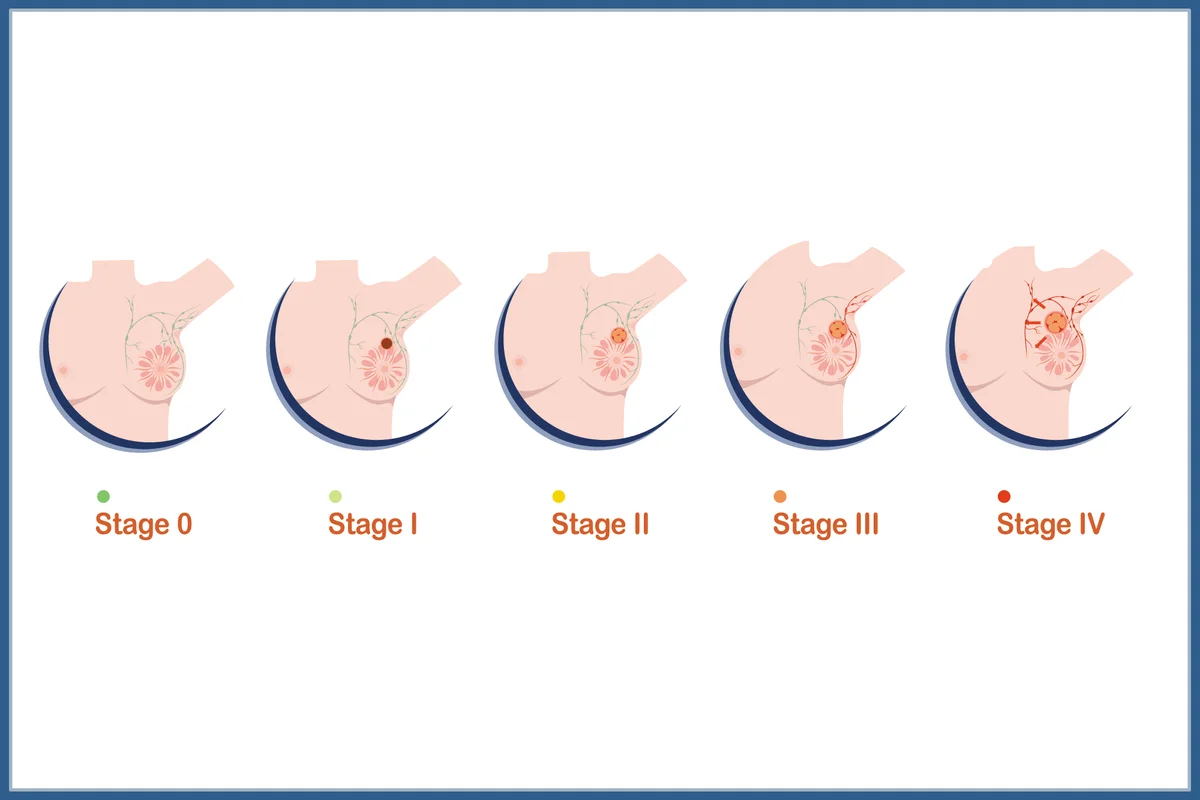If you or someone you know has been diagnosed with breast cancer, you’ve probably heard people ask what stage it is. So, what does that mean?
Breast cancer staging can be complex. But to keep it simple, it’s the process of finding out how much cancer is in your body.
There are several different breast cancer staging systems. The most commonly used is called the TNM system. Staging includes pathologic staging (also called surgical staging) — which means analyzing tissue from the tumor and lymph nodes taken during an operation — and clinical staging, which looks at physical exams, biopsies and imaging tests.
The results offer important details that your healthcare provider uses to stage your breast cancer. Most staging systems consider:
- Size of the tumor
- Number of tumors
- Whether the cancer has spread to the nearby lymph nodes
- Whether the cancer has spread to other parts of the body (metastasis)
- How similar the cancer cells look to healthy cells, which can affect how fast the tumor may grow and spread (grade)
- Whether the cancer has estrogen and/or progesterone receptors that make it grow (biomarkers)
- Whether the cancer cells make too much HER2 protein, which makes cancer grow
- Gene expression profile results that can indicate how your genes could affect your cancer growth and response to treatment
Staging can happen before you start treatment, but the stage of breast cancer can also change throughout the treatment plan (for example, if the size of a tumor changes with radiation or chemotherapy, you may be at a different stage).
Knowing the stage is important because it helps determine:
- Treatment options
- How likely the treatment is to be successful
- How serious the cancer is
The rule is the lower the stage number (0-4) the less cancer there is in the body.
Read: Don’t Put Off Breast Cancer Screening — It Could Save Your Life >>
Of course, nothing is simple when it comes to cancer. On top of the stage numbers, there’s also sub-stage letters to help your healthcare providers and you get more precise details, such as whether there is cancer in the lymph nodes.
Here’s the basic information to know about the stages of breast cancer and common treatment options for each stage. Often, a combination of treatments is used.
Stage 0 breast cancer
Cancer cells are non-invasive or pre-invasive and have not spread outside of the ducts into the surrounding breast tissue.
- Also called ductal carcinoma in situ (DCIS)
Treatment options for stage 0 breast cancer
- Breast-conserving surgery (e.g., lumpectomy or partial mastectomy)
- Mastectomy
- Radiation
- Hormone therapy
Stage 1 breast cancer
Cancer is small and contained to the area where the first cells began to develop, or a very small amount of cancer is found in the sentinel lymph node (the first lymph node where breast cancer can spread).
- Stage 1A breast cancer: The tumor is smaller than 2 centimeters and lymph nodes are not affected
- Stage 1B breast cancer: The cluster of cells is less than 2 millimeters (the width of a grain of rice) with or without a tumor in the breast
Treatment options for stage 1 breast cancer
- Breast-conserving surgery (e.g., lumpectomy or partial mastectomy)
- Mastectomy
- Radiation
- Hormone therapy
- Chemotherapy
Stage 2 breast cancer
Tumors are bigger compared to stage 1 but are still in the breast and/or nearby lymph nodes.
- Stage 2A breast cancer: Tumor is less than 2 centimeters and has spread to 1 to 3 lymph nodes, or the tumor is 2-5 centimeters without spreading to the lymph nodes
- Stage 2B breast cancer: Tumor is 2-5 centimeters and has spread to 1 to 3 lymph nodes or larger than 5 centimeters and has not spread to the lymph nodes
Possible treatments for stage 2 breast cancer
- Breast-conserving surgery (e.g., lumpectomy or partial mastectomy)
- Mastectomy
- Radiation
- Hormone therapy
- Targeted drug therapy
- HER2 targeted therapy
- Immunotherapy
Stage 3 breast cancer
Tumors are large and growing into surrounding tissues and/or have spread to lymph nodes but not other organs.
- Stage 3A breast cancer:
- Cancer has spread to 4 to 9 lymph nodes or has enlarged the internal mammary lymph nodes in the chest, or the tumor is more than 5 centimeters and cancer has spread to 1 to 3 lymph nodes or any breastbone nodes
- Stage 3B breast cancer:
- A tumor of any size has grown into the chest wall or skin and/or spread to 9 lymph nodes
- Stage 3C breast cancer:
- No tumor in the breast or any size tumor in the breast. Cancer in 10 or more axillary (underarm) lymph nodes, internal mammary nodes or lymph nodes near the collarbone
Treatment options for stage 3 breast cancer
- Surgery (most often mastectomy)
- Chemotherapy
- Radiation
- Targeted therapy
- Hormone therapy
There is a high likelihood that a combination of treatments will be used for stage 3 breast cancer.
Stage 4 breast cancer (also called metastatic breast cancer)
The cancer has spread outside of the breast and nearby lymph nodes to other parts of the body which may include the lungs, bones and liver.
- Tumors can be any size
- Stage 4 breast cancer is considered incurable and is treated a chronic condition
Watch: Resources for Patients with Metastatic Breast Cancer >>
Possible treatments for stage 4 breast cancer (metastatic breast cancer)
- Chemotherapy
- Targeted drugs
- Immunotherapy
- Hormone therapy
Radiation and surgery may also be an option depending on diagnosis.
- Breast Cancer Screening & Testing ›
- Metastatic Breast Cancer ›
- Breast Cancer ›
- New Treatments for Metastatic Breast Cancer ›
- Fact or Fiction? Breast Cancer ›
- Finding Hope in the Face of Incurable Breast Cancer - HealthyWomen ›
- Bra or No Bra? Navigating the Post-Mastectomy World - HealthyWomen ›






